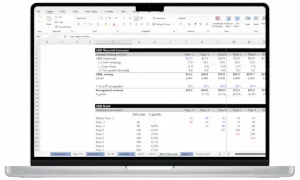If you’ve spent any time in the software or investing world, you’ve probably heard of the Rule of 40. What is it? How do investors calculate at this number? How do you use the Rule of 40? Is it the answer to all life’s riddles? 🙂
You may have asked yourself all these questions. (Well, except the last one, maybe.) In this article, I’ll demystify the Rule of 40 once and for all.
What is the Rule of 40?
The Rule of 40 is an investor’s calculation for assessing the efficiency of a privately held SaaS (software as a service) company.
The definition of the Rule of 40 is that software companies are most efficiently run (and therefore, more attractive for investment) when the sum of their year-over-year growth rate percentage and its profit margin percentage is at least 40%.
Like this:
YoY Growth % + Profit Margin Percentage = 40% (or more)
Why is the Rule of 40 important?
The Rule of 40 is important because SaaS companies have such a unique financial profile when compared to traditional service companies. Ultimately, the Rule of 40 helps investors compare across software companies at different stages of growth to assess how efficiently they are being managed.
That is, if a software company is slow growing, it may still be attractive since it has high (enough) margins to clear the Rule of 40 threshold. Meanwhile, if a software company is faster growing, it may still pass the Rule of 40 even if it is not as profitable as other companies. In a sense, the Rule of 40 is an “efficient frontier” by which SaaS management teams should seek to optimize their company and tradeoff against two variables.
As a fairly new industry that has seen leaps of growth in the past decade, investors need to have some solid metrics to evaluate SaaS companies, and traditional financial ratios may be less effective. Different industries have different ratios and average growth rates, and the Rule of 40 seems to be what works best for SaaS companies.
Calculating the Rule of 40
The first thing to realize when calculating the Rule of 40 is that the company you are analyzing has to be somewhat mature for the Rule of 40 metric to be useful. The earliest stage startups cannot use the Rule of 40 in a meaningful way because they are still building out their product offering, finding their ideal market/customers, and developing revenue streams.
The year-over-year growth rate of the Rule of 40 is usually based on an ARR (annual recurring revenue) comparison. Since quite a bit of SaaS companies’ revenue is usually subscription-based and is thus recurring, the recurring revenue is a nice, clean metric for how much the company has grown over the preceding 12 months.
The profit margin percentage is usually based on EBITDA (earnings before interest, taxes, depreciation, and amortization) compared with gross revenue. EBITDA is a useful measure for this calculation because it shows the earnings of the company without the non-cash expenses of depreciation and amortization, or the company’s tax treatment and interest expense, which can vary depending on the company’s level of debt or tax jurisdictions.
With a pure Rule of 40, then the profit margin and growth rate can be any two figures that add up to 40.
Weighted Rule of 40
Some investors may prefer a “weighted Rule of 40” that gives twice as much emphasis to growth over earnings. The weighted rule of 40 is calculated as:
(1.33 x Growth)+(0.67 x Earnings) = 40
This can be especially important for smaller SaaS companies that need investors, but may not have the robust earnings of a larger company.
Rule of 40 examples
As stated above, the Rule of 40 definition means that a company’s earnings and growth rate must add up to at least 40%. If the company’s earnings and growth rate add up to less than 40, it is a sign that the company needs to increase one or both metrics to operate efficiently compared to peers and to become interesting to possible investors.
15% Growth rate + 35% EBITDA = 50
Company has strong earnings
65% Growth rate + -10% EBITDA = 55
Company has strong growth
10% growth rate + 15% EBITDA = 25
Company should take action to increase one or both metrics
Adding the weighted EBITDA into the calculation changes it a bit, but the basic idea remains the same.
While it seems like a “quick-and-dirty” sort of calculation, the Rule of 40 has become a popular metric for CEOs and investors to assess their company’s overall strength and efficiency.

- 33 lessons
- 8+ video hours
- Excels & templates
Rule of 40 companies
Rule of 40 companies are usually ones that have a mix of high growth and profitability. Rule of 40 companies often have a few years of operating history, and may be later stage startups or even public companies.
Some examples of Rule of 40 companies include:
- Bill.com
- Blend Labs
- DataDog
- Docusign
Rule of 40 valuation
The Rule of 40 impacts valuation for SaaS companies (which I cover in detail in my growth equity course) in a few ways. One way is that it can help investors quickly assess the financial health and efficiency of a company.
While scoring well on the Rule of 40 can lead to a stronger perception by investors, it is still possible for companies to achieve a very high valuation multiple, even when they do not meet the Rule of 40.
One example is MongoDB, which is a great company, but does not “pass” the Rule of 40. Investors still favor this company (and reward it with a high multiple relative to peers) because they believe it has a large market opportunity, etc.
How the Rule of 40 impacts SaaS Companies
Rule of 40 SaaS companies tend to be late-stage growth companies that are maturing into market leaders. Earlier startups might utilize a Weighted Rule of 40 until they get past the rapid growth stage and have their companies stabilized.
CEO’s can use the Rule of 40 as a general rule of thumb to see where they need to focus their company’s priorities, and ensure that they are not sacrificing too much growth for increased earnings.
The two Rule of 40 metrics together touch many strategic decision-making areas for CEO’s and investors. Balancing and nourishing them both is the way to lead the company into the future.
Rule of 40: EBITDA, gross margin, or net income?
There are many different ways to measure a company’s profitability.
- EBITDA (earnings before interest, taxes, depreciation, and amortization) is a measure of a company’s profitability that excludes these non-cash expenses.
- Gross margin is a measure of a company’s profitability that includes all costs of goods sold
- Net income is a measure that includes all GAAP expenses, including non-cash ones
- Free cash flow margin takes into account all expenses but normalizes for non-cash expenses
While the most common definition of the Rule of 40 utilizes EBITDA, sometimes investors will elect to use one of these other margin percentages, depending on the situation.
Rule of 40 vs Rule of 50
The Rule of 50 is a similar rule to the Rule of 40, but it simply has a higher threshold for “passing” as the name implies. The Rule of 50 is less commonly used than the Rule of 40, but it can be helpful in certain situations.
Summary
The Rule of 40 has become a popular metric for CEOs, investors, and boards to assess software companies. The Rule of 40 is a simple calculation that can give CEOs and investors a quick assessment of a company’s financial efficiency.
The Rule of 40 allows investors to benchmark companies across a range of growth and profitability levels. It is most often applies to later stage startups or even public companies.
To go even deeper, check out my article series diving into SaaS metrics. Or, to achieve mastery, reserve your spot today in my online course on SaaS metrics and financial modeling.


 SaaS & Growth Metrics
SaaS & Growth Metrics Break Into Growth Equity
Break Into Growth Equity
